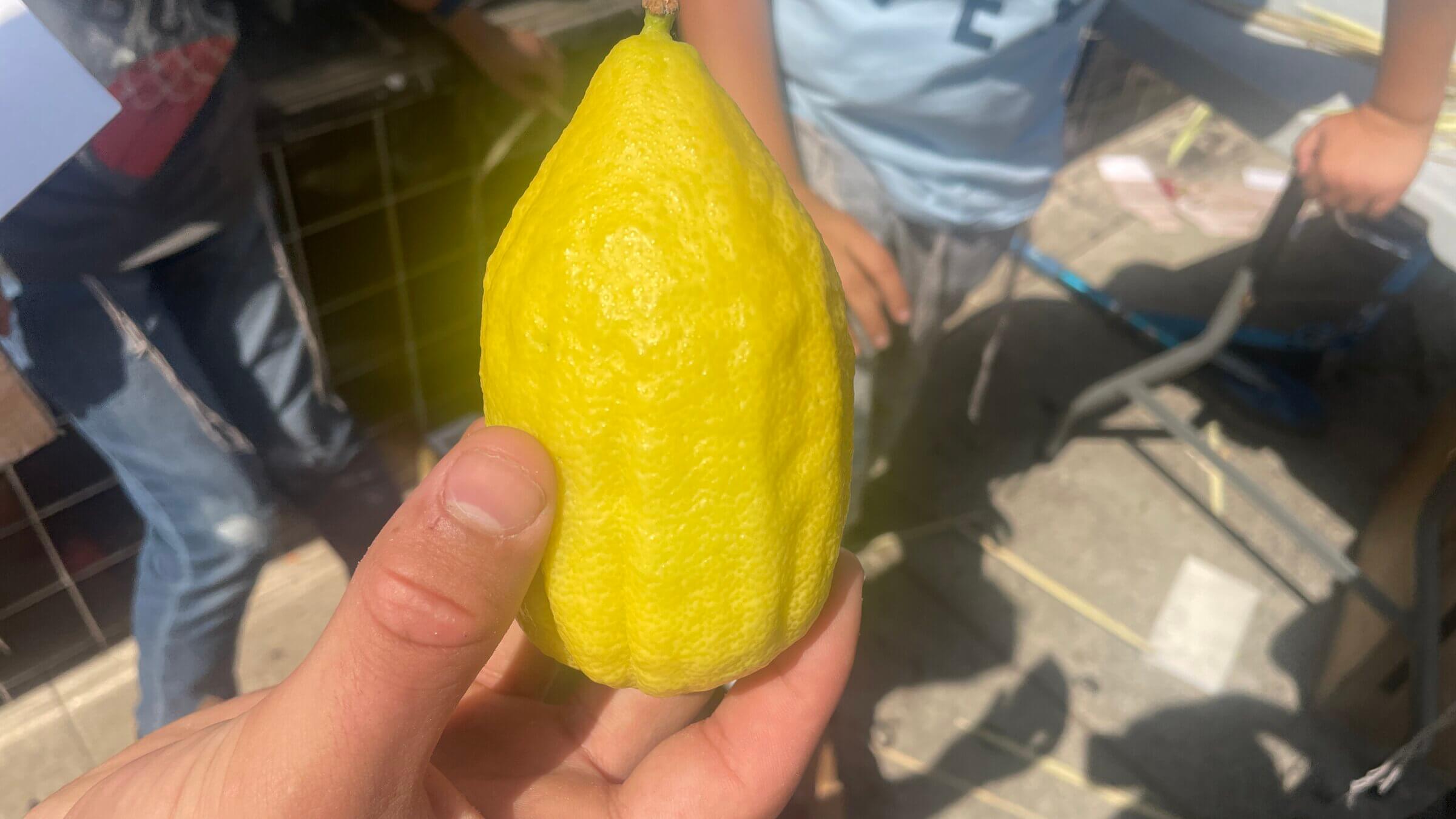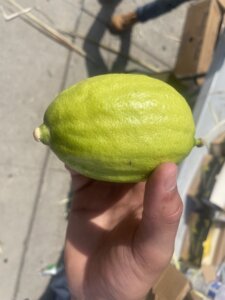What’s the difference between a $40 etrog and a $100 etrog? You’ll need to squint to find out.
Color and size are rarely the determining factors

Pick a winner! Photo by Louis Keene
The etrog was shaped like a grenade, and that was apparently a good thing.
“It’s called a gartel,” 16-year-old Jacob Ghanem told me, referring to the way the chartreuse Moroccan citron was concave at its waist, forming a convenient hand-grip. The etrog was also free of speckles: no scratches or tiny brown spots. He was selling it for $100.
We were standing on a shady corner in the heart of Pico-Robertson, the largest Orthodox neighborhood in Los Angeles, where Jacob was one of several young vendors who’d set up shop for the week. With Orthodox schools closed between Yom Kippur and the end of Sukkot, dozens of their students were selling lulav-and-etrog sets to passersby who have come to count on them.
They wake up as early as 2 a.m. to get prime real estate around kosher restaurants and groceries. The sets include the four species — palm, willow and myrtle branches, plus etrog — required to fulfill one of the core commandments of the holiday, but the price is all about that little yellow fruit. On this corner, they started around $40 and ranged up to $100.
Ever been curious about what makes an Etrog worth more or less?
Allow Jacob Ghanem, a 10th grader at YULA who set up shop on a busy Pico-Robertson corner, to guide you through his wares: pic.twitter.com/c6V4VYRNJ0
— Louis Keene (@thislouis) September 28, 2023
Religious Jews make a special blessing over the lulav and etrog and shake it in a certain pattern each morning of the eight-day harvest festival, and parade around with it during services on the seventh day, known as Hoshanah Rabah. Most sets sold in the U.S. are imported from Israel.
I’d long wondered what makes a certain etrog worth more or less — to the casual viewer, they look and smell pretty much the same. But after hearing from these kids about what makes the ultimate etrog mehudar — a Hebrew term from the Torah that is translated as “aesthetic beauty” or, more poetically, “above and beyond” — I’ll never look at them the same.
The main thing that diminishes value, the young vendors told me, are nicks or dings on the surface. You might need a loupe to spot these impurities, which sometimes appear in between the fruit’s natural lumps — which themselves are a good thing, as long as they’re not, you know, too lumpy.
Squint at your $40 etrog, and you might find a few places where it looks like was poked with a dirty needle. Or maybe there’s only one spot like that, but it’s close to the fruit’s stem — in Hebrew, pitom — which is seen as the most important part. Etrogs without the pitom can still be used, but generally sell for less.

Does size matter? “People like big ones,” said Benny Lumer, a 10th-grader who was operating the table next to Ghanem’s. But Benny said he’d also seen small ones sell in the triple digits.
And when it comes to color, beauty is in the eye of the beholder. Benny said that Jews of Yemenite or Moroccan heritage tend to favor the green ones, but this was not a scientific survey.
He slowly rotated a $70 etrog in his hand like a precious jewel. “You see how there’s nothing there?” Lumer said, holding it up to the sun. “It’s perfectly clean.”
The kids told me that everyone in the neighborhood buy from the same three wholesalers, which import from Italy, Morocco, and Israel. Some consider the Italian fruit the fanciest, but not Benny.
He’d brought along a few friends from Yeshiva Ohr Elchonon Chabad and Cheder Menachem. They were part of a larger crew of a couple dozen yeshiva boys who were spread out across town. They planned to split the profits.
Benny said he was putting the money toward his first car — a hybrid, he hoped. Likely a used one, and preferably, one without too many spots.
A message from our Publisher & CEO Rachel Fishman Feddersen

I hope you appreciated this article. Before you go, I’d like to ask you to please support the Forward’s award-winning, nonprofit journalism so that we can be prepared for whatever news 2025 brings.
At a time when other newsrooms are closing or cutting back, the Forward has removed its paywall and invested additional resources to report on the ground from Israel and around the U.S. on the impact of the war, rising antisemitism and polarized discourse.
Readers like you make it all possible. Support our work by becoming a Forward Member and connect with our journalism and your community.
— Rachel Fishman Feddersen, Publisher and CEO






























